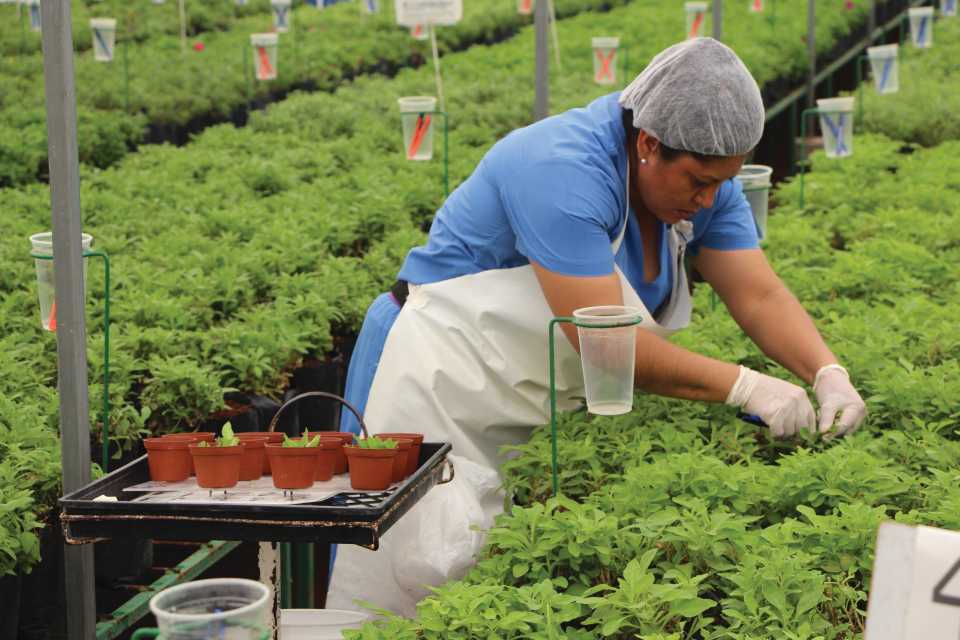How Ergonomics Training Can Improve Your Greenhouse Worker Productivity
 Micro-ergonomics is the art of identifying the smallest flaws in a production process and avoiding the accumulation of very large inefficiencies. It starts with attention to the details of production practices, and it requires knowledge about the principles of how to get the most production from the least stress on the human body. These principles are well researched and readily available. Other industries have embraced them with good results. Would they be worthwhile considering for the greenhouse?
Micro-ergonomics is the art of identifying the smallest flaws in a production process and avoiding the accumulation of very large inefficiencies. It starts with attention to the details of production practices, and it requires knowledge about the principles of how to get the most production from the least stress on the human body. These principles are well researched and readily available. Other industries have embraced them with good results. Would they be worthwhile considering for the greenhouse?
I wonder how many growers know how to determine the ideal height of a workstation surface. If you are mostly typing on a keyboard, the top of the workstation should form a horizontal line with the bottom of your elbow, so that your upper arms and forearms form a right angle.
However, if you have to move your arms about, e.g. while sticking cuttings, the workstation should be slightly lower than your elbows, so that upper arm and forearm form a slightly larger angle of approximately 120°. The larger angle will significantly reduce shoulder strain from movement of the forearm.
How many among you are able to work ambidextrously? Working simultaneously with two hands is very awkward for beginners. It requires significant coaching and practice to become routine, but it is a very rewarding skill once it has been mastered. If, for example, you are able to process and stick unrooted cuttings with two hands simultaneously and with the same accuracy as one hand would allow you, then it would nearly double your productivity.
If you learn ambidexterity properly, such two-handed work will not cause you more effort or stress. The only expense for this increase in productivity comes from learning the method. Therein lies the rub, though, because it is nearly impossible to learn how to work two-handed, unless you have a teacher with the knowledge to first teach you the necessary hand-eye coordination, and with the patience to guide you to success in small steps past the inevitable frustration of first attempts.
Commitment to teaching in small steps and the ability to analyze tasks to small details is encompassing for the subject of greenhouse ergonomics. Micro distances, for example, can have an enormous impact on performance and worker fatigue, but they are generally overlooked, because we are too focused on big pictures and large numbers. Spend some time and observe the posture of your workers and the distance that they cover with their arms, hands, and shoulders for each motion. Deliberately think about options for very specific training, for a change in equipment, or for a modified layout that could improve results. Are there motions that could be eliminated or distances that could be reduced?
Here’s one example: The hand of a worker at a transplant line makes the same motion every three to four seconds, or about 10,000 times in a nine-hour shift. We can reduce the total movement distance for the hands of each worker by 1 full mile every day, if we can re-arrange the layout of the workstation so that we can improve posture and reduce the distance covered by each hand from 12 inches to 6 inches.
Repetitive motion injuries are not only placing immense costs on our industry and on our staff, but they contribute to the unnecessary public image of greenhouse work as back-breaking. Among the culprits that could be easily eliminated is cross-handed work, one of the key contributors to very sore shoulders at the end of a work week. I see it all the time: A right-handed person uses their leading hand to reach far over their left body line to pick up a flowering plant for packing and sleeving. The cart or monorail is to the right of the worker. Every time the worker picks up a pot, the shoulders are forced to crunch, the trapezius muscle gets stretched to one side only, and the discs in the spinal column are being exposed to a grinding swivel motion. This is not just uncomfortable and unhealthy for the worker, but it is simply detrimental to productivity.
“Do not cross your hands while working” was a mantra that was preached to horticulture apprentices of my time by every supervisor. We were in trouble if our right hand reached beyond the triangle that was formed by our left shoulder, our left knee, and the furthest extent of our workplace. We were forced to re-think our sequence of motion, so that we would avoid these inconspicuous and pain inducing motions, which accumulated to a significant impact on the bottom line.









